Epsom salt plays a great role for both indoor and outdoor plants. It benefits all flowering plants in many ways. But, will it prove to be beneficial for Hibiscus plants? Let’s find out.
Epsom salt works great for Hibiscus planted in the ground and pots. It increases magnesium and chlorophyll production, improves nutrient absorption and balance, prevents root shock, and controls pests. However, don’t skip general fertilizers as Epsom salt doesn’t contain all the nutrients.
This article will share the reasons for using Epsom salt and its benefits. I will also share how to use it and the result of the overdose.
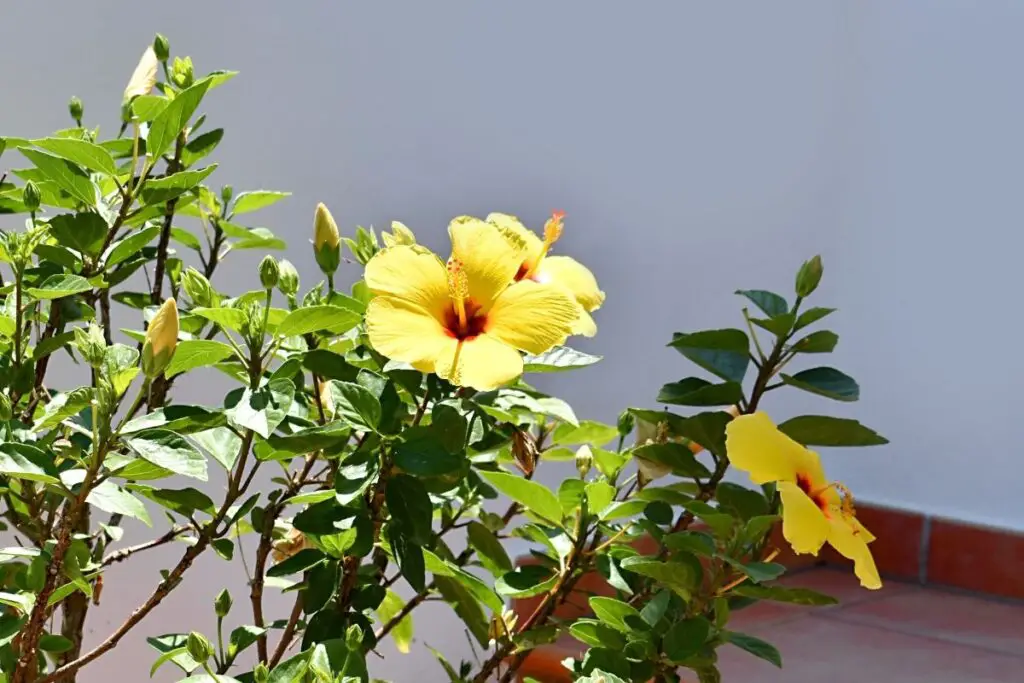
What is Epsom salt?
Epsom salts are natural minerals made from hydrated magnesium sulfate.
It consists of 10% magnesium and 13% sulfur.
Epsom salts were discovered from an underground spring in the Epsom town in England during the early 1600s.
This salt has been used for years to treat several conditions in plants, animals, and even humans.
These salts play a great role in improving the nutrient content and the overall growth and development of the plant.
Is Epsom salt good for the Hibiscus plant?
Epsom salt helps the Hibiscus plants in many ways.
The components in the Epsom salt, i.e., magnesium and sulfur, help increase the plant’s health.
Epsom salt also helps in encouraging the Hibiscus plants to re-bloom after the winter months.
Using the salt as foliar spray promotes profusely blooming.
However, Epsom salt won’t solve all the problems of the plant.
Using only Epsom salt as a fertilizer won’t be enough for the Hibiscus plants.
The NPK value for Hibiscus fertilizer should be 17-5-24.
But, the NPK for Epsom salt is 0-0-0. So, you can’t use Epsom salt alone.
Also read: What Is A Good Fertilizer For Hibiscus Plants? (Ideal Ratio+Best Pick)
When and why should I use Epsom salt for Hibiscus plants?
Generally, Hibiscus will require Epsom salt when it lacks magnesium content.
It is an essential nutrient every plant requires.
It helps in the production of chlorophyll and maintains the green color of the leaves.
Without magnesium, Hibiscus cannot produce chlorophyll, and without chlorophyll, the plant will slowly die.
Sometimes, we use fertilizers having excessively high potassium content.
Indeed Hibiscus likes a high amount of potassium, but it shouldn’t be extremely high.
With heavy doses of potassium, you need to increase the magnesium content to maintain the green, glossy leaves.
Poor, hard, alkaline soil and lack of fertilizer or fertilizers lacking in magnesium can also cause magnesium deficiency.
How will you understand that the plant does not have enough magnesium?
| Symptom | Description |
|---|---|
| Yellowing of leaves | Leaves turn yellow, starting from the tips and edges |
| Leaf curling | Leaves curl downwards |
| Stunted growth | Plant growth slows down |
| Brown spots | Brown spots appear on leaves |
Generally, yellow leaves are the signs of many issues.
But in magnesium deficiency, only the older leaves will become yellow, and their veins will be dark green.
The leaves will also become yellow or brown in between the veins.
The plant passes on the magnesium to the new young leaves.
Due to this, the lower older leaves lack this nutrient and develop green-veined yellow color.
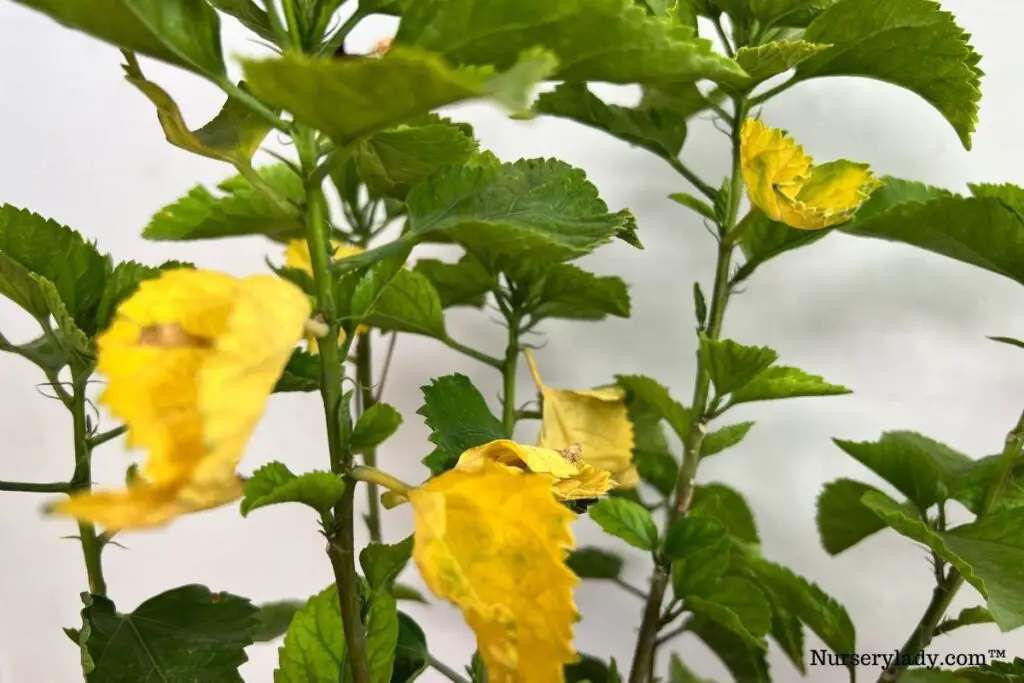
Also read: Why Are My Hibiscus Leaves Turning Yellow? (Causes+Fix)
How to use Epsom salt for Hibiscus plants?
| Plant Size | Amount of Epsom Salt |
|---|---|
| Small (less than 1 ft) | 1 tbsp |
| Medium (1-3 ft) | 2 tbsp |
| Large (3-6 ft) | 3 tbsp |
| Extra Large (more than 6 ft) | 4 tbsp |
There are multiple ways of using Epsom salt in different situations.
For using it in the soil to increase magnesium content, follow the following ways:
- First, water the plant and moisten the soil will plain water.
- Next, add some Epsom salt to the soil surface.
- Water lightly to moisten the salt.
If you are using containers:
- Add 1 teaspoon of salt to a 4-inch pot.
- Use 2 teaspoons for a 6-inch pot.
- Add 1 tablespoon to an 8-inch container.
- Add 2 tablespoons to a 2-gallon container.
- Use ¼ cup for large plants in the ground.
You can also mist the plants with Epsom salt.
Add 2 tablespoons of Epsom salt to one gallon of water.
Apply this once a month.
For more frequent watering, use 1 tablespoon of salt.
For using Epsom salt as a foliar spray, add 1 teaspoon of Epsom salt with 1 liter of water and spray it to the foliage.
Use it once a month for new growth and flowering.
Foliar spraying with Epsom salt will provide the plant with sufficient magnesium needed for chlorophyll production.
It will also improve the photosynthesis, leaf color, and overall growth and development of the Hibiscus plants.
For using it with fertilizer, mix one tablespoon each of balanced fertilizer with NPK value 20-20-20, Epsom salt, and potassium nitrate with one gallon of water.
Use it once in spring and again in the fall.
Don’t use more than one tablespoon of potassium nitrate.
Otherwise, the plant may get burnt.
To make an organic liquid fertilizer with Epsom salt:
- Take 4 dried banana peels, 3 eggshells, and 4 tablespoons of Epsom salt and grind them in a mixer.
- Add 75 ml of water to the ground mixture and shake it well to mix it.
- Water your plant with this mixture.
Also read: How To Water Hibiscus Plant? (How Much, How Often & More)
Looking for gardening supplies? We have tested 100's of products before recommending them to you guys. Check out our best pick below:
| Image | Gardening Supplies | Best Price? |
|---|---|---|
 Top
Top Top
Top | Raised Garden Bed Kit | Check On Amazon |
 | XLUX Soil Moisture Meter, Plant Water Monitor, Soil Hygrometer Sensor for Gardening, Farming, Indoor and Outdoor Plants, No Batteries Required | No Results |
 Top
Top Top
Top | 82 Pcs Garden Tools Set and Extra Succulent Tools Set | Check On Amazon |
 | Joeys Garden Expandable Garden Hose with 8 Function Hose Nozzle, Lightweight Anti-Kink Flexible Garden Hoses, Extra Strength Fabric with Double Latex Core, (50 FT, Black) | No Results |
 Top
Top Top
Top | Dual Chamber Compost Tumbler | Check On Amazon |
 Top
Top Top
Top | Sunnyglade Plant Stakes | Check On Amazon |
 Top
Top Top
Top | Organic Cold Pressed Neem Seed Oil | Check On Amazon |
 Top
Top Top
Top | Mighty Mint Gallon :-Insect and Pest Control Peppermint Oil | Check On Amazon |
 Top
Top Top
Top | Scotts DiseaseEx Lawn Fungicide | Check On Amazon |
 Top
Top Top
Top | Jacks Classic 20-20-20 All Purpose Fertilizer | Check On Amazon |
 Top
Top Top
Top | 30,000 Seeds Pollinator Attracting Wildflower Mixture | Check On Amazon |
 Top
Top Top
Top | Survival Vegetable Seeds Garden Kit-Over 16,000 Seeds | Check On Amazon |
What are the benefits of using Epsom salt in the Hibiscus plant?
| Benefit | Description |
|---|---|
| Improved growth | Epsom salt provides magnesium and sulfur, which are essential nutrients for plant growth |
| Increased flower production | Magnesium helps plants produce more flowers |
| Pest control | Epsom salt can deter pests such as spider mites and aphids |
| Stress relief | Epsom salt can help plants recover from stress caused by drought or transplanting |
Other than adding magnesium, there are many other profits of using Epsom salt in the Hibiscus plant.
Since Epsom salt is a great source of sufficient magnesium and sulfate, it can impressively increase the plant’s health.
Here, I will be sharing some advantages of using Epsom salt in Hibiscus.
Encourages growth
Since Epsom salt is hydrated magnesium sulfate, it increases the content of magnesium in Hibiscus plants which also helps in the production of chlorophyll.
It further helps in maintaining the green color of the leaves.
Also read: How Fast Do Hibiscus Plants Grow? (Hibiscus Growth Rate )
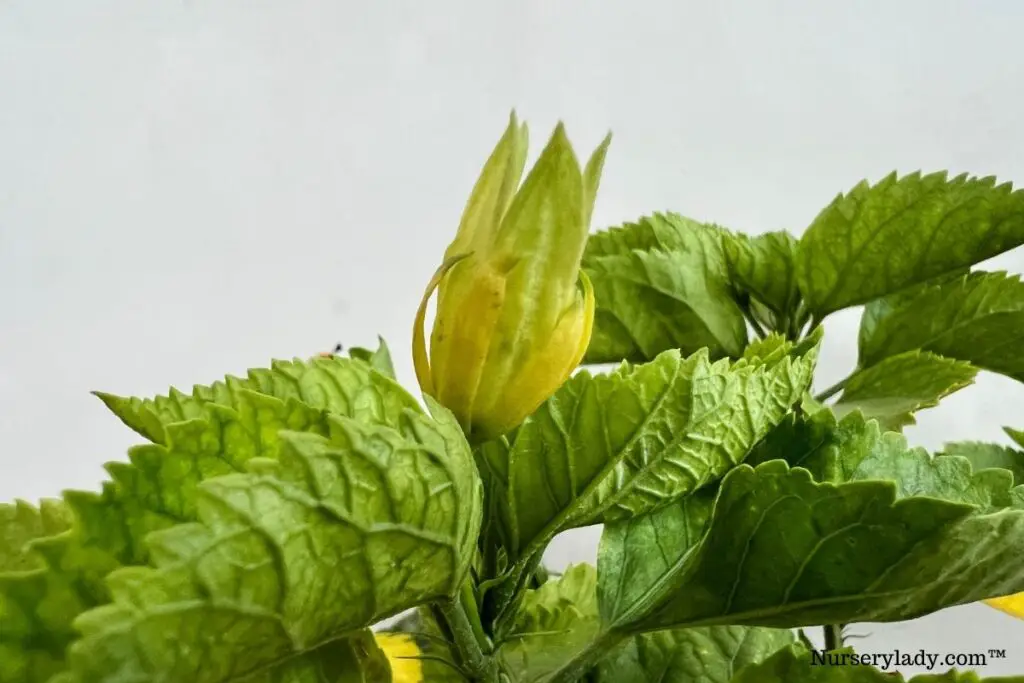
Prevents root shock
When you transplant your Hibiscus plant for any purpose, it can shock the roots since they shift from one place to another.
Besides, the plant faces an environmental change.
It can shock the roots for which they cannot absorb the nutrients properly.
It results in wilted or yellow leaves.
Epsom salt can help prevent this root shock by increasing chlorophyll and aiding the roots in absorbing the nutrients properly.
Heightens the nutrient absorption
Before adding Epsom salt to the soil, check the soil to know what minerals are present.
If magnesium is perfect, adding Epsom salt can cause an overdose.
Adding Epsom salt increases magnesium and heightens the plant’s absorption speed.
Epsom salt contains magnesium and sulfur, which further helps the Hibiscus plant to absorb essential nutrients like nitrogen, potassium, and phosphorus.
Apply Epsom salt in small quantities only once a month.
Before applying, check whether the plant has any stress or not.
Avoid using the salt if the plant is unwell.
Balances the level of nutrients
If your plant is not responding, it could be due to a lack of nutrients.
And, Hibiscus owner knows that this plant is a heavy feeder.
Sometimes, low pH level also reduces the magnesium content in the soil.
It causes an imbalance in the nutrition levels.
To balance it, add Epsom salt to the plant to correct the magnesium level and create a good balance in the nutrition level.
Increases flowers and flower size
Applying Epsom salt as a foliar spray once a month provides Hibiscus will enough magnesium required for chlorophyll.
It also improves the development of flowers and their size.
Also read: When Do Hibiscus Bloom? (+How Long Does A Hibiscus Bloom Last)
Pest control
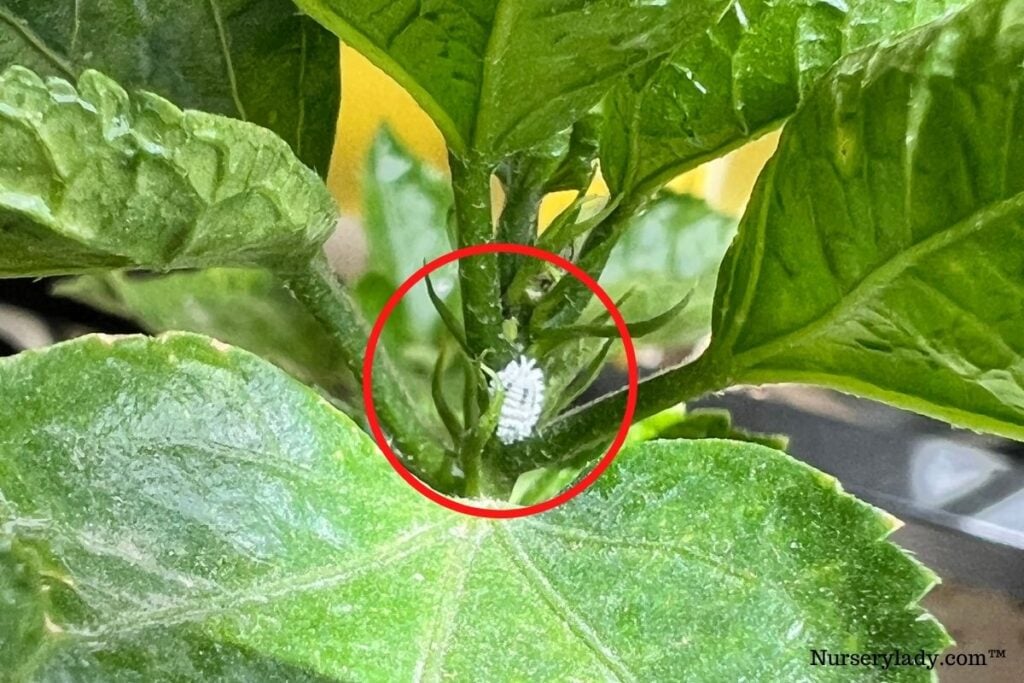
Epsom salt is also helpful in deterring pests like beetles or slugs.
However, it won’t solve the problem to a great extent.
Thus, it shouldn’t be your first or main resort.
For removing bugs like beetles, add one cup of Epsom salt with five gallons of water.
Transfer the mixture to a spray bottle, shake well, and spray the leaves, especially the affected ones and where you find the bugs.
For removing pests like slugs, sprinkle the dry salts around the plant base.
Also read: How Do I Get Rid Of Bugs On My Hibiscus? (Common Bugs+Fix)
What are the effects of Epsom salt overdose?
Using Epsom salt indeed helps Hibiscus plants in many ways.
But that doesn’t mean you should use it in huge amounts or too frequently.
There is a limit to using it.
Besides, you don’t need to use it if your plant is doing fine till now.
If you use it frequently and apply it even if your plant doesn’t need it, it will face certain consequences.
Wilted plant
Excessive use of the Epsom salt increases the amount of salt in the soil.
When this happens, the salts absorb all the moisture from the soil, for which the plant cannot receive enough water.
Lack of moisture will result in wilted, yellow leaves.
You use only use it if your plant has a magnesium deficiency.
Use the exact amount. As for the foliar spray, apply it only once a month for big blooms.
Nutrition imbalance
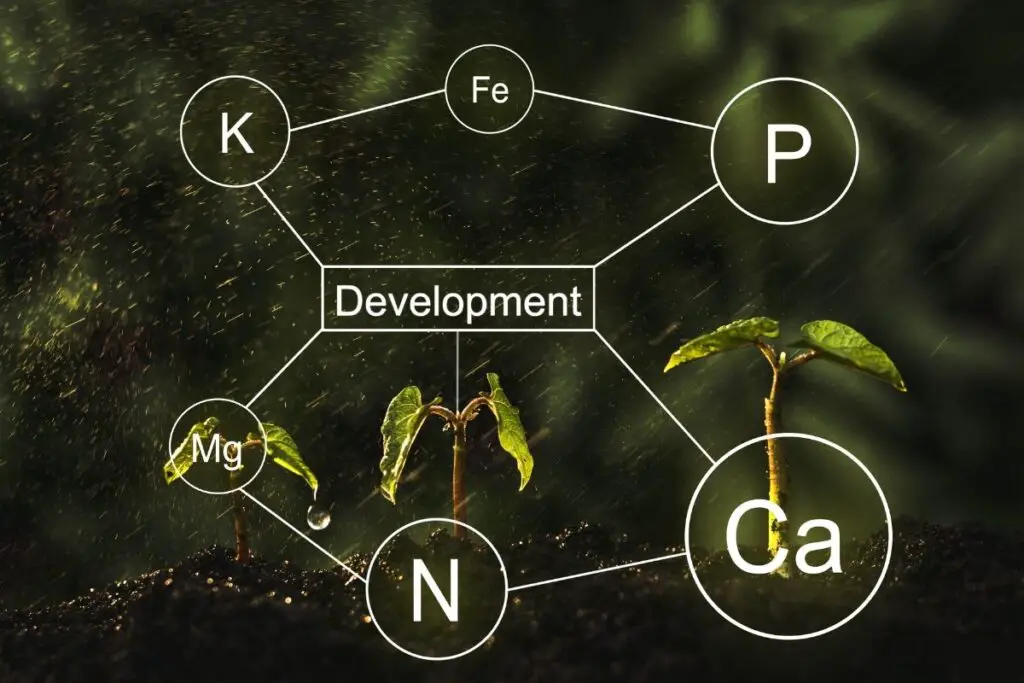
Excessive use of Epsom salt increases the magnesium level in the soil.
A high amount of any nutrient can imbalance the nutrition level.
This imbalance will not allow the Hibiscus plant to grow properly.
It will hurt the plant and result in poor development.
Excess Epsom salt releases aluminum from the soil
Aluminum is a toxic metal that can be deadly for your Hibiscus plant.
Adding Epsom salt too much or too frequently releases aluminum from the soil.
Such a condition prevents the plant from developing roots properly.
Therefore, the plant will stop growing and eventually die.
Leaf burns
If your plant already has enough magnesium levels, excess magnesium can cause salt injury and burn the leaves.
Excess use will worsen the plant’s development.
Such a condition further invites pest and fungal infections.
Wilting of the plant
If your Hibiscus plant has faced any stress and is fighting for life, don’t apply Epsom salt in such conditions.
It will deteriorate the plant’s condition more and ultimately kill it.
Before applying Epsom salt, check the plant’s health and see whether it has any issues.
If the plant faces any troubles, wait for the plant to recover.
When should you not use Epsom salt?
There are many situations where you should use Epsom salt.
Similarly, there are some conditions where you should not use Epsom salt.
As the main fertilizer

Epsom salt is only capable of providing magnesium to the soil.
They don’t contain any other major or minor nutrients.
Hibiscus requires average nitrogen, low phosphorus, and high potassium.
It also requires other minor nutrients like calcium, iron, copper, manganese, etc.
Epsom salt doesn’t have these nutrients.
Using this salt as the major fertilizer will make the plant deficient in the essential nutrients and die due to this shortage.
Use Epsom salt to amend the nutrition level and not the main fertilizer.
Epsom salt has a 0-0-0 NPK value, and Hibiscus requires a 17-5-24 NPK value.
Not all plants with magnesium deficiency need Epsom salt.
Sometimes, Hibiscus plants will suffer from magnesium deficiency if the phosphorus content is high.
Many beginners use high phosphorus content fertilizers to encourage profuse blooming in the plant.
But, high phosphorus blocks the plant from absorbing minor nutrients, including magnesium.
Fixing the problem with Epsom salt here is pointless because the plant already has magnesium.
The absorption has been blocked due to phosphorus.
So, instead of adding Epsom salt, correct the phosphorus level.
Final thoughts
Hibiscus plants are easy to grow if provided with the right requirements at the right time.
Epsom salt can greatly help develop the Hibiscus plant’s overall growth and health. They help increase magnesium levels, create balance in the nutrient level, and encourage profuse and big blooms.
Don’t use it if the plant doesn’t need it or facing problems. If Hibiscus is magnesium deficient, it could be due to high phosphorus. So, check that issue first and then apply it. Rather, send your soil for a test.
Reference: Wikipedia, ASPCA, Louisiana State University Agricultural Center, American Society for Horticultural Science, Tropical Hibiscus by Texas A&M University, Sciencedirect.
